Last week and the week before, we looked at beautifully pearl-embroidered mitres from Italy and France. Today, we will look at probably the most spectacular pearl-embroidered mitre of them all: the mitre made by Hans Plock for Cardinal Albert of Brandenburg in AD 1514 in Halle, Germany. The piece is permanently displayed at the Rüstkammer in Dresden, Germany (Inv. Nr. i. 0086). Apart from the outstanding embroidery, the real treat is that we know quite a bit about Hans. He was an interesting character who lived at most interesting times. Let’s get acquainted!
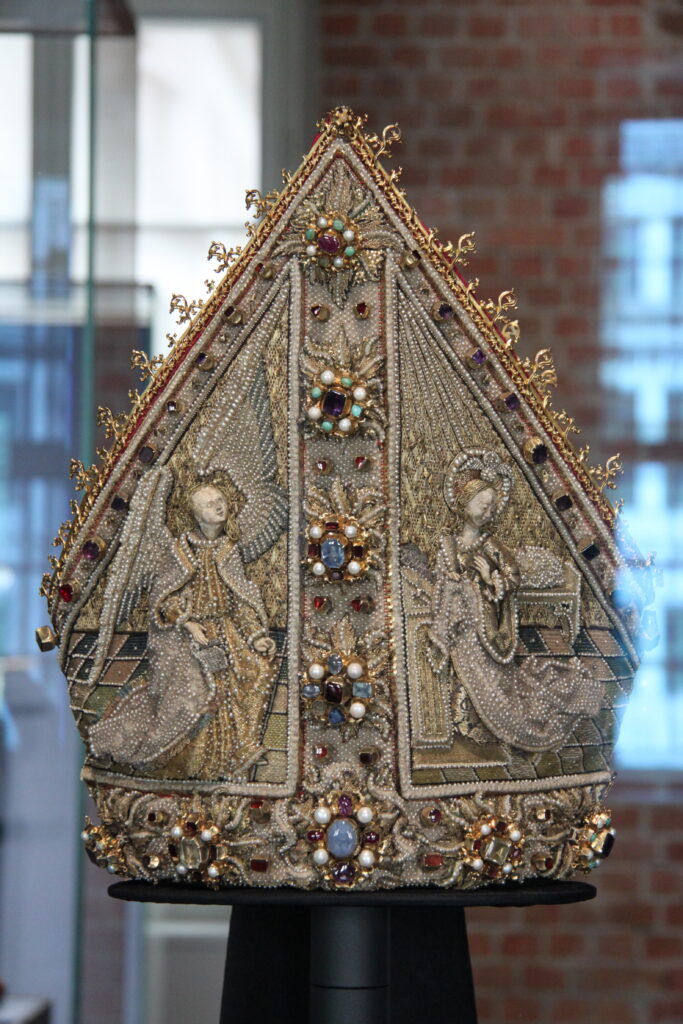
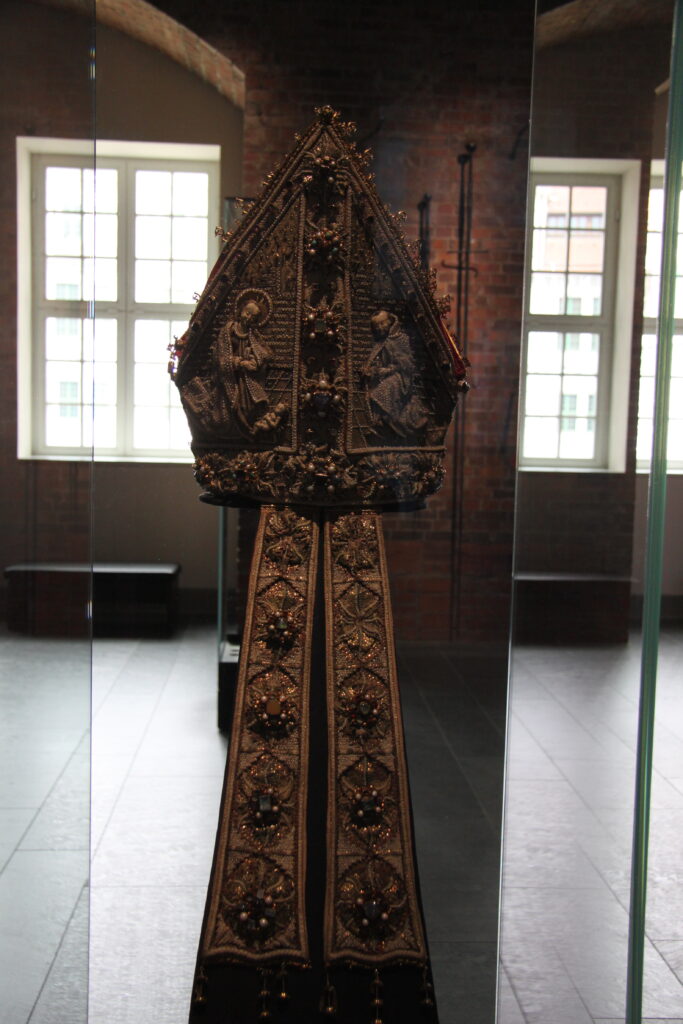
The sumptuously decorated mitre shows on the front the Annunciation and on the back the Nativity. The mitre’s lappets are decorated with floral motives heavily encrusted with pearls and precious stones. The mitre weighs an impressive two kilos and is 42,5 cm high. It is not fit for a wearer with a delicate frame. Although no direct documentary evidence exists, it is commonly accepted that silk embroidered Hans Plock (c. AD 1490-1570) made the mitre around AD 1514 in Halle (Germany) for Cardinal Albert of Brandenburg (AD 1490-1545).
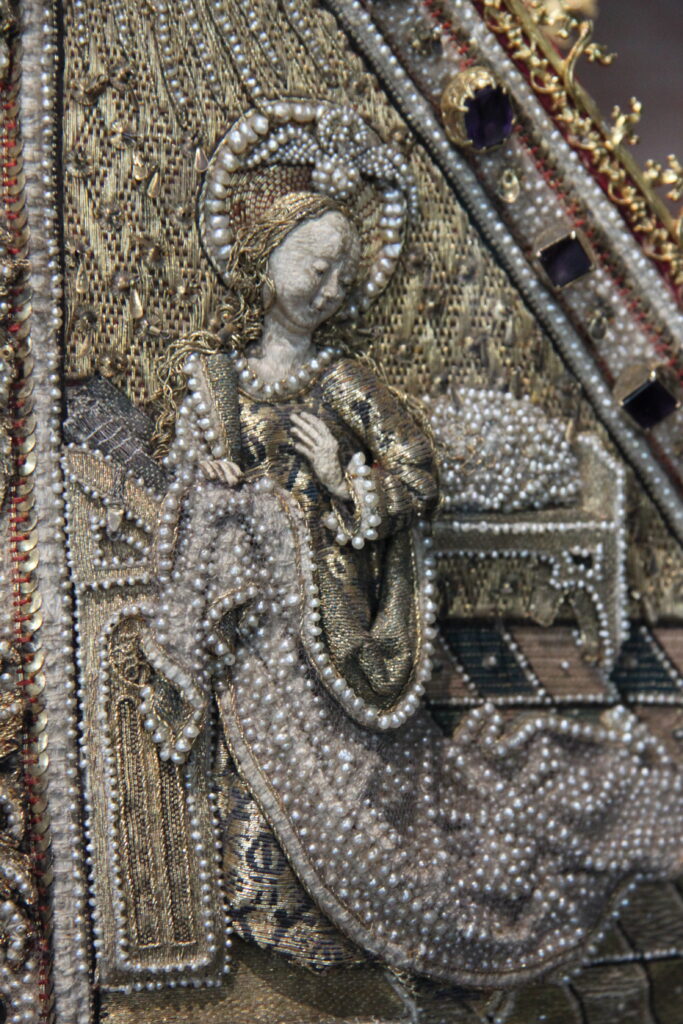
All the embroidery you see in the above picture is executed on linen. The figures were made separately and appliqued onto the linen background. The elevation off the ground fabric is quite impressive and would definitely go by the name of stumpwork. I would love to know how Hans was able to model the delicate faces. What kind of padding is in there? The hands are more conventional stumpwork made by wrapping wire with silk. You can find instructions in most modern-day stumpwork project books.
The embroidery materials are also very cleverly used to imitate other materials. For instance, look at Mary’s undergarment. Hans has imitated a heavy patterned silk fabric by placing the dark-blue couching stitches just so. By grouping the fresh-water pearls according to their size, Hans was able to accentuate the folds and recesses.
The background behind Mary is quite typical and has all the ingredients we see in gold-embroidered orphreys of the time. There’s the tiled floor and the diaper pattern background (a basket weave). It is just over the top embellished with pearls and gemstones (turquoise, garnet, amethyst, tourmaline, aquamarine, and rock crystal).
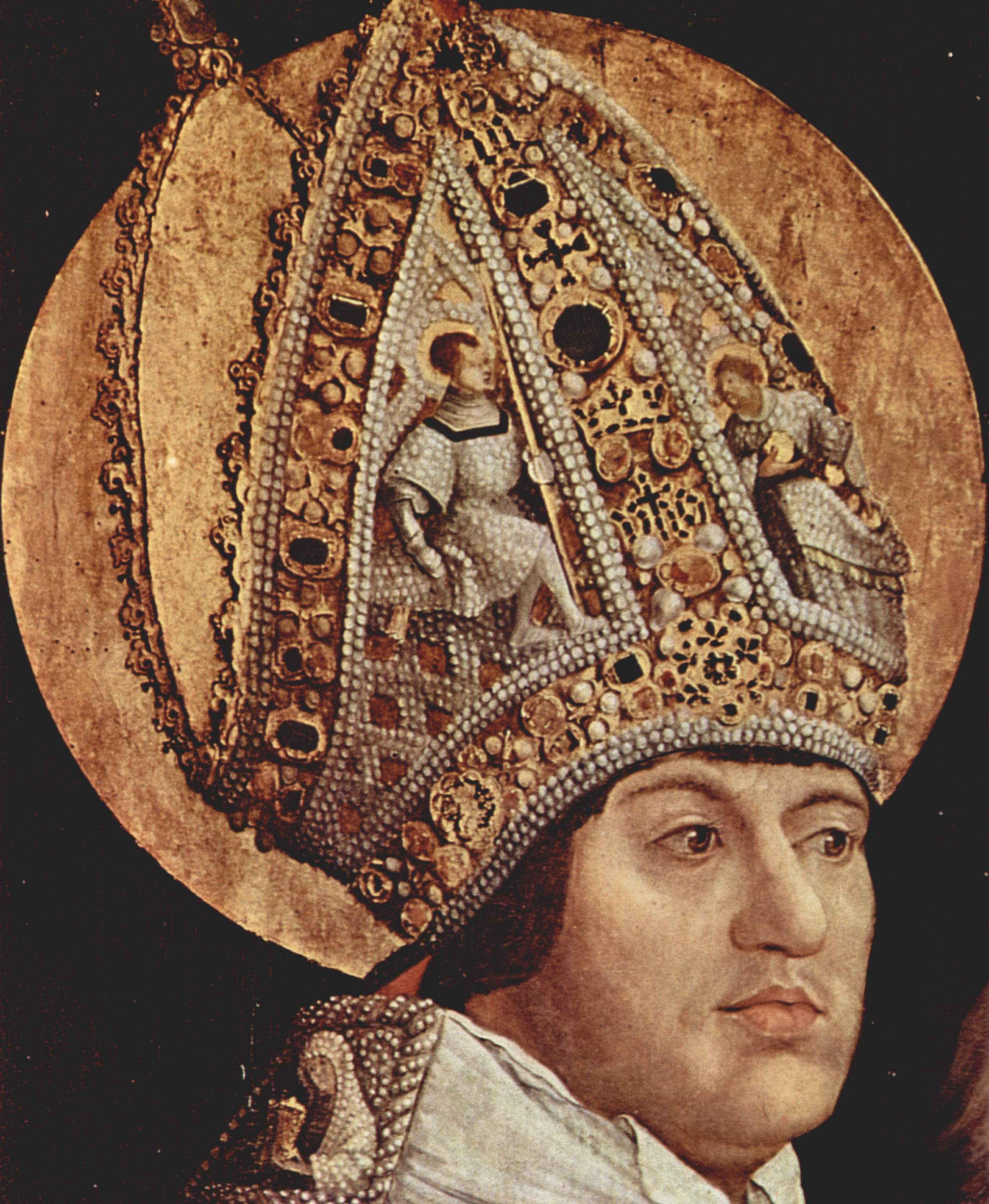
While there’s no shortage of images depicting Cardinal Albert (above, even with a pearl-embroidered mitre not unlike the one I am showing you!), we don’t have an image of Hans Plock. But we do have his Luther bible. And he used his bible as a kind of diary. In the margins, it contains comments on the political situation or on scripture. Just think of this: Hans became a staunch Protestant whilst working at the court of Cardinal Albert in Halle. Albert left Halle in 1541 when the town became protestant. Hans decides not to come with Albert and stays in Halle.
What do we know about Hans’ career as a silk embroiderer? He was born around AD 1490 in Mainz, Germany. He probably learnt the trade of silk and pearl embroiderer in Mainz. Between AD 1509 and 1512, he is a journeyman in Trier (Germany). He became a master in AD 1515 and entered the court of Albert. He followed Albert in AD 1521 to Halle (Germany) and produced beautiful goldwork and pearl embroideries for Albert until at least AD 1532. But they end up on either side of the religious divide. Hans remains in Halle when Albert returns to Mainz in AD 1541.
Hans was part of a circle of artists and artisans. Matthias Grünewald (who painted Albert multiple times) was a close friend. However, his bible also contains drawings and engravings made by Albrecht Dürer (AD 1471-1528), Martin Schongauer (c. AD 1450-53 – 1491) and Lucas Cranach the Elder (AD 1472-1553). You can find pages of this exceptional document of a silk embroiderer here. His friendship and acquaintance with his time’s leading painters and engravers show that embroidery artists did not work in isolation.
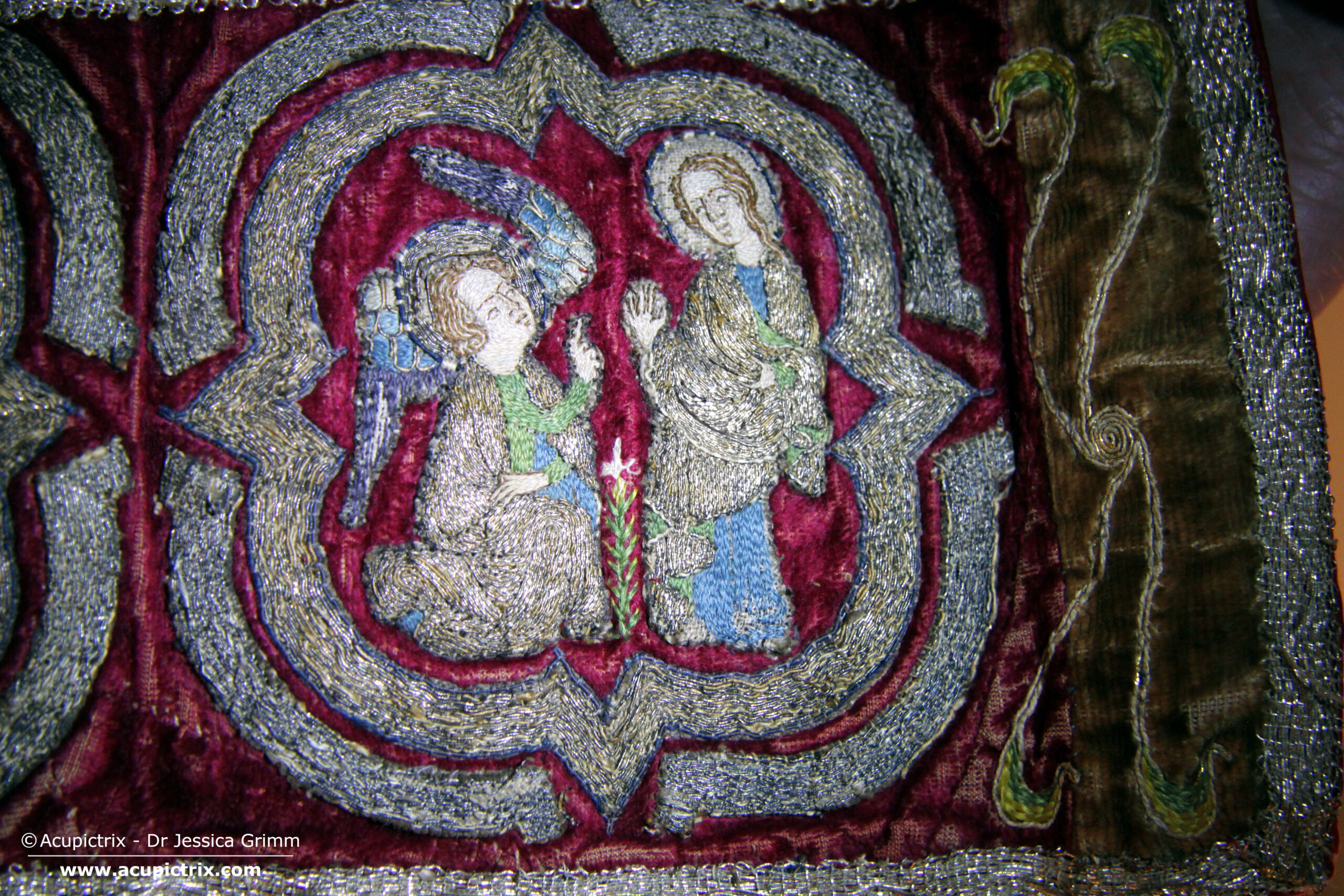
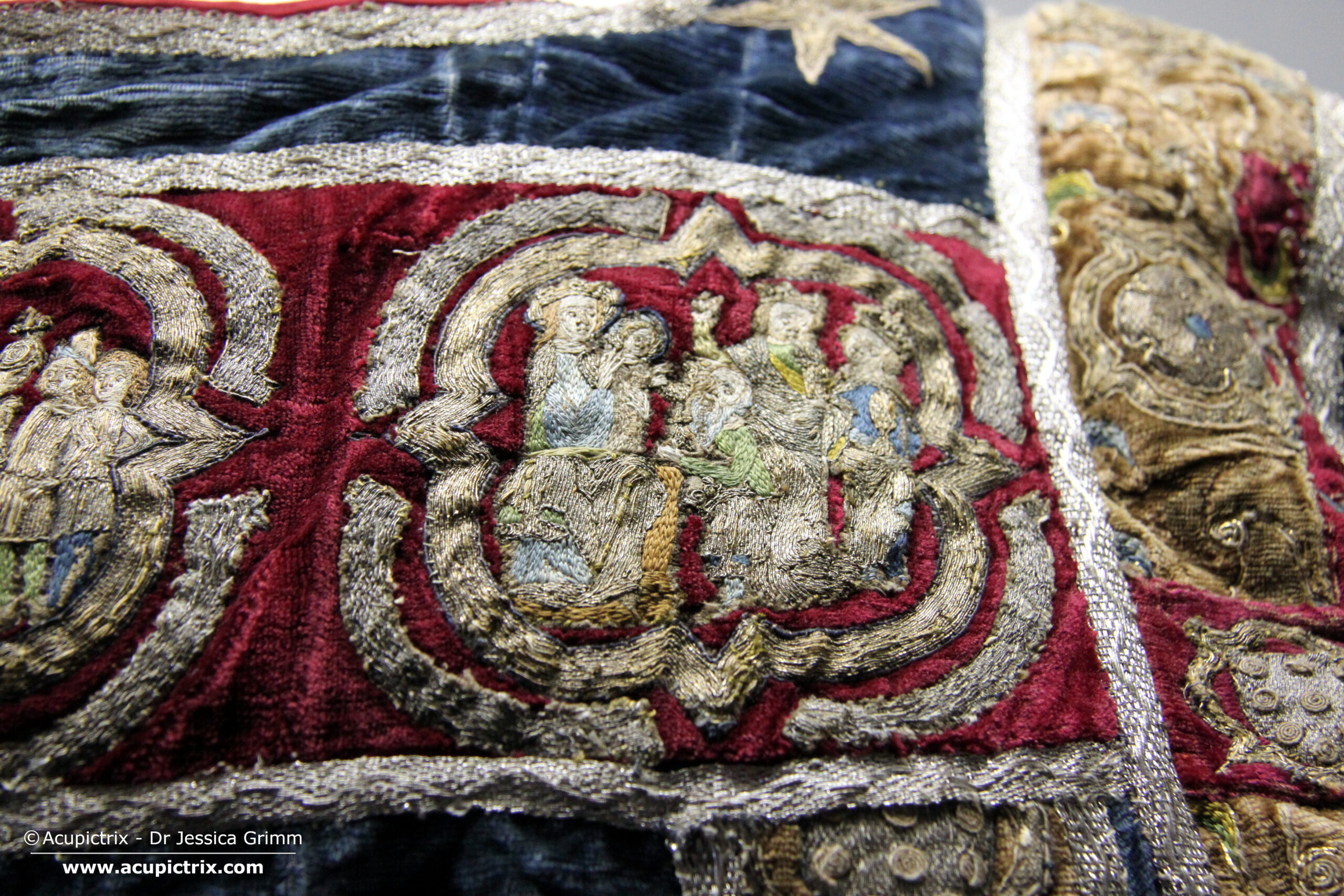
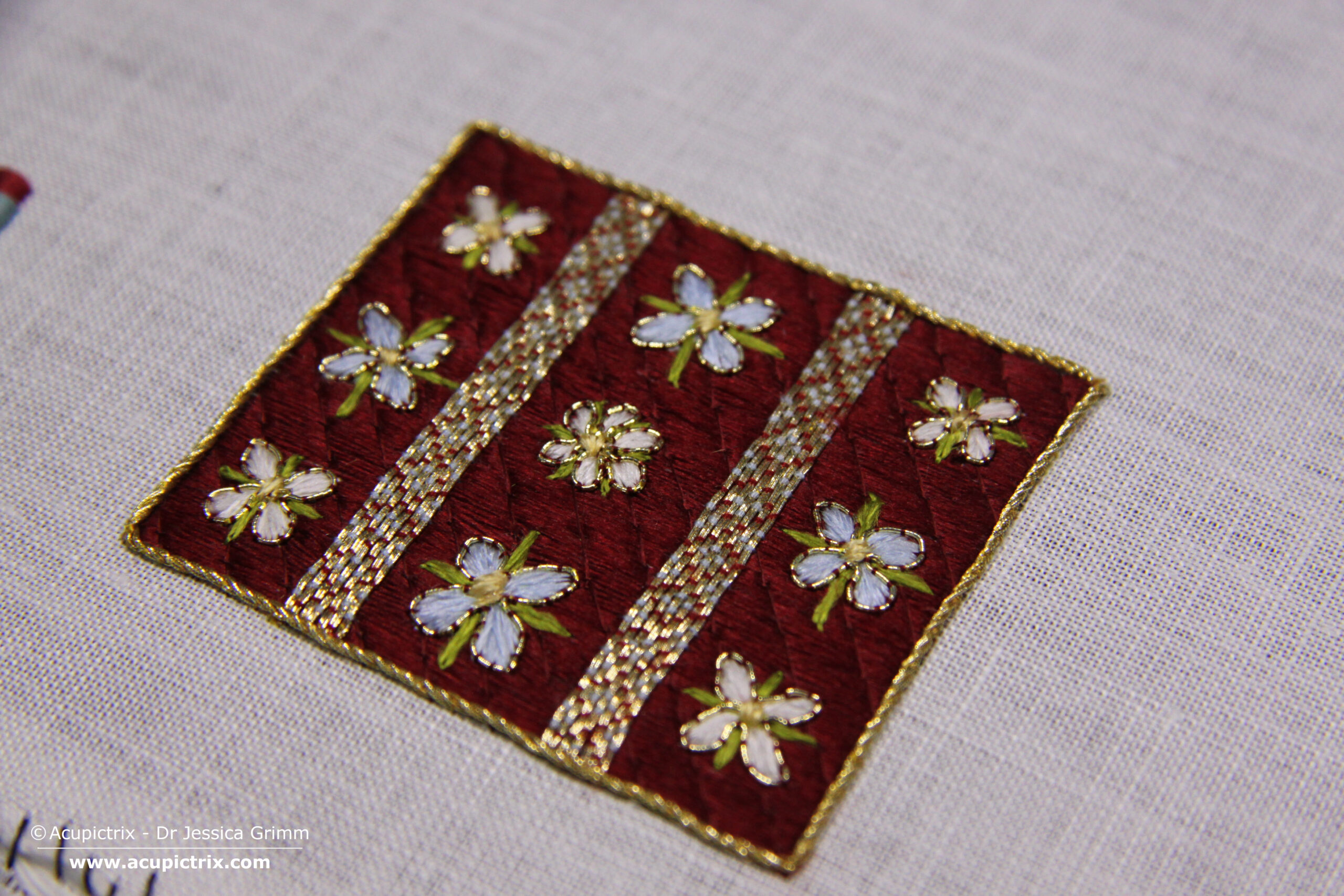
10 Comments
Beth · 20. January 2025 at 16:58
The detail of Mary (an assumption of her name on my part) is truly amazing! She looks so realistic. I’m still working to get my flat couched gold work embroidery to look good, I can’t imagine doing it in 3-D. Then there’s her flowing hair, not looking like it’s stitched in place. I think I could spend hours staring at the photograph wondering how Hans Plock did the work.
Dr Jessica Grimm · 20. January 2025 at 19:05
Yes, that’s Mary in the Annunciation scene. Sorry, I sometimes forget that the iconography is not clear. I wished Hans had left us a manual. I am sure his theological ponderings are fun too, but …
Cynthia Jackson · 20. January 2025 at 16:59
Jessica, what a wonderful artifact! Thank you so much for drawing our attention to it. I just wish there was more information of this quality available for the embroiderers working in London.
Dr Jessica Grimm · 20. January 2025 at 19:06
This is indeed an exceptional source, Cynthia! I’ve ordered the academic study that has come out in 2021. I hope that there is more commentary on his remarks on his embroidery career.
Elliot Besmann · 21. January 2025 at 0:53
That’s such gorgeous work on the faces too…thank you for sharing the history of this piece!
Dagmar · 21. January 2025 at 9:03
Breathtaking, indeed! I also like Mary`s dress very much! Then I am very fascinated about the 3 dimensional look of the bench right behind Mary. It´s absolutely flawless and realistic. Wow!
When zooming in I find that the pearl covered part of Mary`s garment is made of a net which is laid over fabric (linen? or bundled threads?) which is forming the folds of the garment. That makes it look even more flowing (not sure whether this translates?) Would you agree?
Thank you Hans for this wonderful testimony of your artistry and thank you Jessica for bringing this to our attention!
Dr Jessica Grimm · 21. January 2025 at 10:01
The netting you see is known as conservation net, Dagmar. It is modern.
Dagmar · 21. January 2025 at 22:08
Ah! ok! 😃 Thanks for clarifying!
Monica · 22. January 2025 at 20:14
Really beautiful! Is there any clue to where the pearls came from? Looking at this mitre and all the pearls you see in paintings, it must have been a steady supply source.
Dr Jessica Grimm · 23. January 2025 at 9:21
All clean streams can potentially have oyster colonies. The Plock Bible states that Hans journeyed to Antwerp to buy precious stones and pearls.